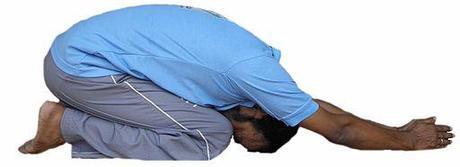… since I don’t actually like it as much. However, my class gave it an enthusiastically positive endorsement, so maybe there’s something I’m not seeing here.
I do know that I designed this class for folks newer to yin, particularly folks who have trouble staying in postures for the full 3+ minutes that’s customary to the style. I have a fair amount of students for whom I think the difficulty is more mental than physical. That is, their bodies are generally cooperative but their minds are often fidgety. And while there is benefit in learning to be comfortable with stillness, “learning” does not necessarily mean “do the whole entire thing right away.”
To that end, this sequence uses pairs of closely related yin poses, held for 90 seconds each, rather than a single pose for 3 minutes. Additionally, there are some gentle flowing movements before and between the longer held poses.
Yin in Training
Time: 35 minutes practicing it alone, 45 when teaching in class
Possible Props: folded blanket, block
Seated Warm Up:
(Using any comfortable seat.)
- Half neck rolls (chin to chest, left ear to left shoulder, chin to chest, right ear to right shoulder), 3 rounds.
- Full neck circles (as appropriate, particularly on dropping the head back), 3 rounds in each direction.
- Seated sun breaths: inhale, interlace fingers in front of chest; exhale, press palms away and round back; inhale, raise palms and arms overhead; exhale, separate hands and drop fingertips by hips; inhale, arch back and lift chest; exhale, release. 3 rounds.
- Seated sun breaths: as above but with the option of clasping fingers behind back (instead of resting by hips) and straightening elbows (instead of only lifting chest). 3 rounds.
- Seated twist, 5 breaths each side.

By Satheesan.vn (Own work) [CC-BY-SA-3.0 (http://creativecommons.org/licenses/by-sa/3.0) or GFDL (http://www.gnu.org/copyleft/fdl.html)%5D, via Wikimedia Commons
Modified Vinyasa:
- Modified child’s pose, with the arms extended but the thighs parallel.
- Inhale to kneeling plank.
- Exhale, lower down.
- Inhale to a comfortable cobra.
- Exhale, lower down.
- Inhale to table.
- Exhale into modified child’s pose.
- Repeat entire vinyasa a second time.
Yin:
- Toe squat, 90 seconds.
- Thunderbolt, with the option to move into ankle stretch or even toward supta virasana, 90 seconds.
- 2 rounds of modified vinyasa.
- Dragon, low with the hands on the ground (or a block), 90 seconds.
- Dragon (right foot forward) with the option to move with the hands resting on the top thigh, 90 seconds.
- 2 rounds of modified vinyasa.
- Sphinx, 90 seconds. With the option to move into seal for the next 90 seconds.
- 2 rounds of modified vinyasa.
- Repeat full dragon sequence — with 2 rounds of modified vinyasa — with the left foot forward.
- Try out deer pose (right leg in front) as an alternative to swan/pigeon. If it feels safe, possibly move into upright pigeon. Hang out for 90 seconds. Then a forward folding (“sleeping”) deer or pigeon for 90 seconds.
- You guessed it: 2 rounds of modified vinyasa.
- Repeat deer/pigeon/swan sequence — including 2 more modified vinyasas — with the left leg leading.
Relaxation:
- Seated spinal twist (any comfortable seat), 5 breaths on each side.
- Half spinal rolls, 3 rounds, with the hands grasping the shins (most limited range of spinal movement).
- Option to repeat or move to 3 rounds of half spinal rolls with the hands grasping mid thigh.
- Option to repeat or move to 3 rounds of full spinal rolls.
- After settling on the floor, supine spinal twist, 90 seconds each side.
- Savasana.

